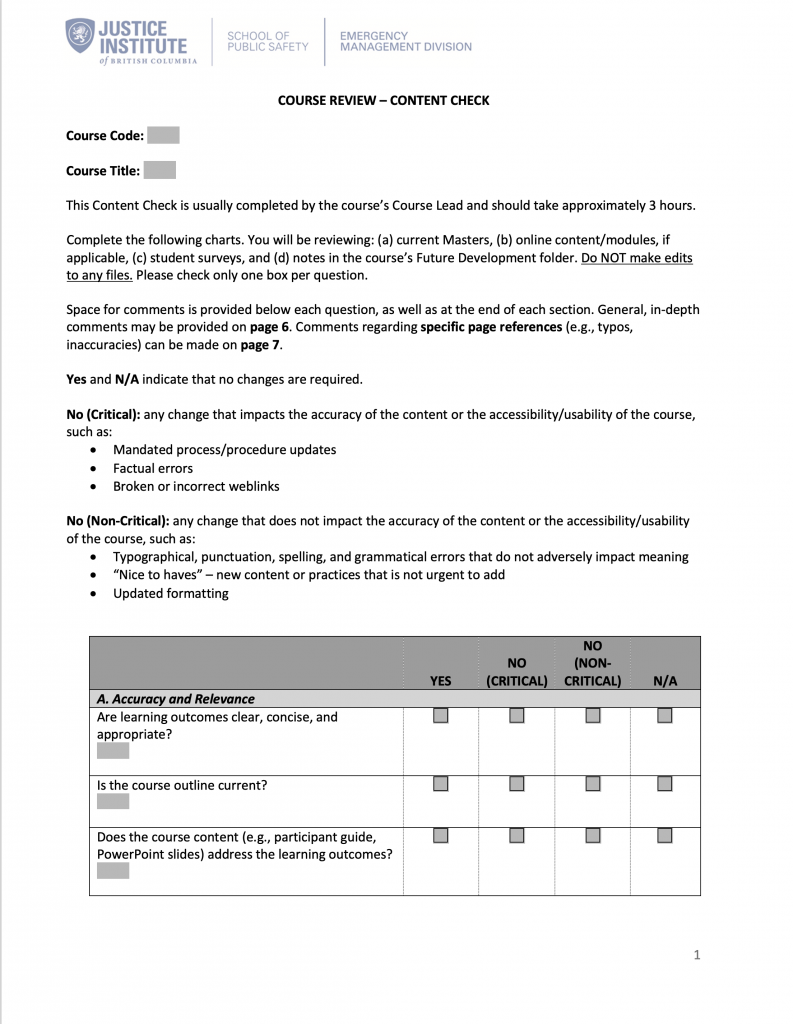Daniella Sieukaran
Daniella is an instructional designer for the Emergency Management Division.

Coursekeeping Day: An Innovative Method for Conducting Course Reviews
As a curriculum designer, I believe that a school is only as strong as its curriculum. It’s easy to think that once we have developed a course, the work is done. However, course review and maintenance are key components of keeping our curriculum effective, accurate, and relevant (EAR!). Although, it’s challenging to find time amongst our daily packed workloads to commit to reviewing our courses. A solution that I implemented within the Emergency Management Division is a “Coursekeeping Day” (like housekeeping!). It was an “all hands on deck” 6-hour day where everyone from PAs to our Dean focused on conducting course reviews on predetermined priority courses. The purpose of having one day devoted to this task was threefold: (1) to ensure that our division got a minimum number of courses reviewed that year, (2) to proactively identify potential issues in our courses for later updating and revising, and (3) to kickstart momentum in cultivating a culture where course reviews are valued and prioritized.
For use on Coursekeeping Day and other course redevelopment work, I developed a two-part set of course review tools that we piloted during that event. The first part is Content Checks, which involved Program Managers and Directors digging into the student and instructor materials to determine if curriculum is still accurate and relevant, such as if current best practices are reflected and if learning outcomes are effectively addressed. These Checks focus on 11 areas: learning outcomes, accuracy and relevance, flow, online content (if the course is also offered online), multimedia, engagement, student assessment, universal design for learning (UDL), course materials, course connections, and common “threads”/themes that we emphasize across our courses (e.g., mental health and resilience). Staff completing these Checks were also provided with past student surveys and informal, unsolicited instructor feedback (collected over time from e-mails) as extra data to inform the course reviews. Those completing Content Checks also gave their course(s) an overall rating on two measures: 
The quality and/or quantity of the proposed changes: Minor revisions being those that do not alter the overall structure, length, or objectives of the course (e.g., rewriting a paragraph in a manual). Major revisions would involve a fundamental re-shaping and redevelopment of the course.
The urgency of the proposed changes: Critical being that the current state of the course limits the accuracy of the curriculum or the (online) user experience, and non-critical being changes that can wait and be implemented long-term.
The second part was Accuracy Checks, conducted by Program Assistants/Representatives/Planners. These Checks focused on identifying issues such as broken weblinks, out-of-date agency/organization names, and old formatting styles.
My supervisor and I (shoutout to Darren!) spent the first hour training the team on the new course review procedure and tools. We also had guests from the other divisions in our School – Fire and DEC at the time – to observe our training session to see if there were any golden nuggets they wished to take back to their own divisions to inform their course review process. Then, each person devoted a solid 4 hours to conducting Content Checks or Accuracy Checks for one or two courses. When possible, we strategically paired reviewers up with courses they were familiar with. This enabled the course review to be accomplished in a relatively short amount of time. It should also be noted that these courses were “short” courses from our certificate and contract training that usually span one or two days. Semester-long courses may require more time to conduct a course review. But, 4 hours is feasible to identify high-level areas of improvement for a semester-long course. We ended the event with a one-hour group debrief (with a pizza lunch!) to determine what worked and didn’t work, so we could refine the procedure and tools.
We reviewed a total of 7 courses that day – much more than we would have reviewed if we didn’t schedule a day exclusively devoted to course reviews. Staff said that Coursekeeping Day made them feel more confident and prepared to tackle more reviews on their own in the future. Staff also appreciated having a specific day set aside for this initiative.
We all work in education because we want to give our students the best learning experience possible. By completing course reviews, we can ensure that our curriculum is something we can continue to be proud of and that maintains our reputation as a leader in public safety.
If you would like to chat about how to implement a Coursekeeping Day in your division, please do reach out to me and I can provide support and training as needed.





